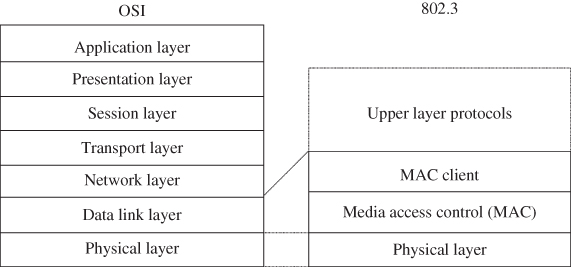Chapter 5Local Area Networks
5.1 Introduction
In this chapter, we discuss different flavors of local area networks (LANs). The specific topics to be covered include the following:
- (a) Ethernet LANs
- (b) Gigabit Ethernet
- (c) Wireless LANs
- (d) Token ring LANs.
5.2 Ethernet
The Ethernet is the most widely used LAN technology. The data rates of the most popular versions of Ethernet are as follows:
- 10 Mbps
- 100 Mbps, which is usually referred to as the Fast Ethernet
- 1000 Mbps (or 1 Gbps), which is the Gigabit Ethernet.
An Ethernet LAN may use coaxial cable, special grades of twisted pair wiring, or fiber optic cable. “Bus” and “Star” wiring configurations are supported. Ethernet devices compete for access to the network using the carrier sense multiple access with collision detection (CSMA/CD) protocol. Ethernet LANs are defined in the IEEE 802.3 standards. The IEEE 802.3 LAN network architecture follows the hierarchical model, as shown in Figure 5.1. The MAC client sublayer is called the logical link control (LLC) when an end system, such as PC, is transmitting data. It is called the bridge entity when it is used for LAN-to-LAN interconnection.

Figure 5.1 IEEE 802.3 Protocol Architecture.
5.2.1 Ethernet Frame Structure
Figure 5.2 illustrates the format of an Ethernet frame, which is similar to the IEEE 802.3 LAN frame. In the remainder of this chapter, we use the term ...
Get Fundamentals of Data Communication Networks now with the O’Reilly learning platform.
O’Reilly members experience books, live events, courses curated by job role, and more from O’Reilly and nearly 200 top publishers.

